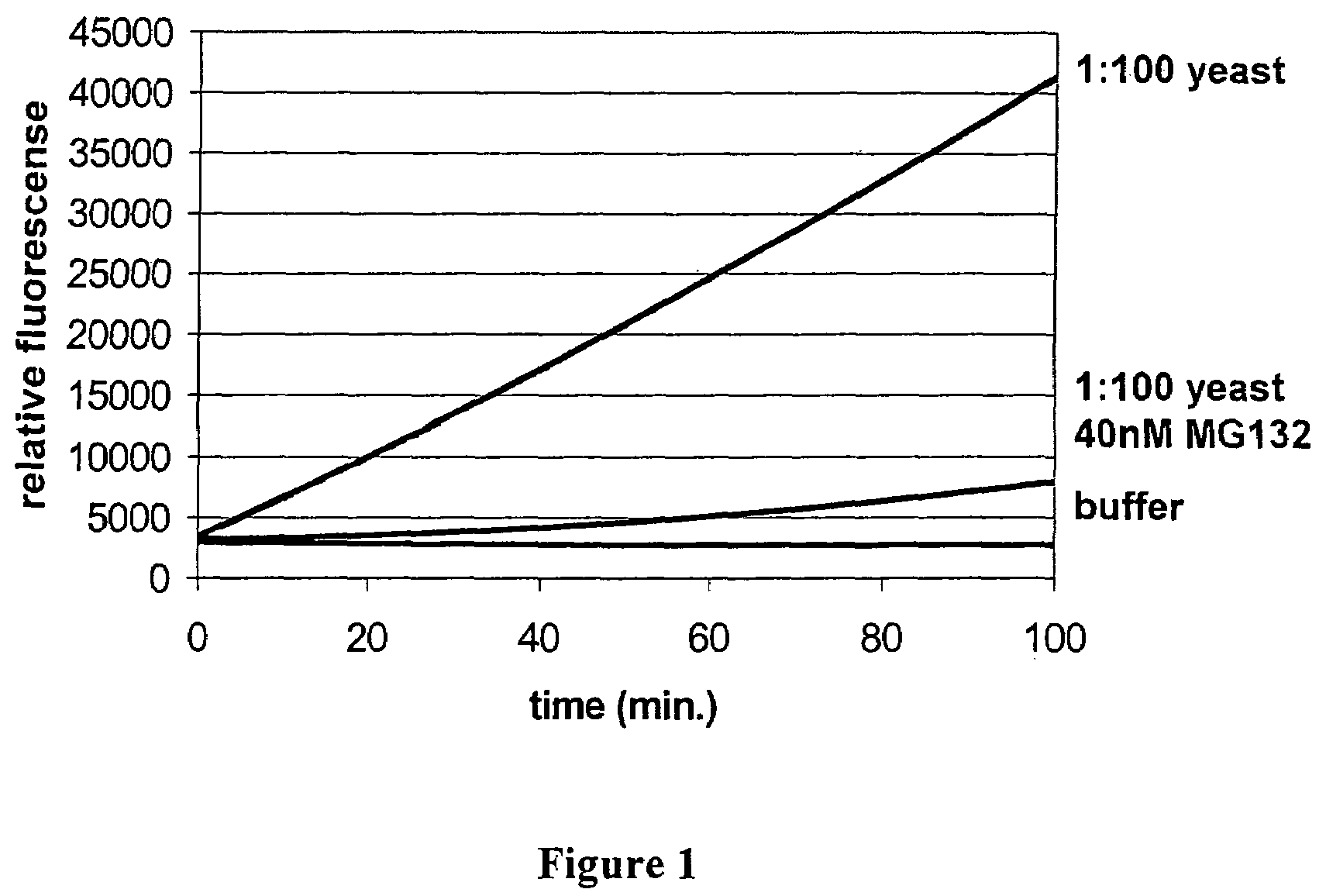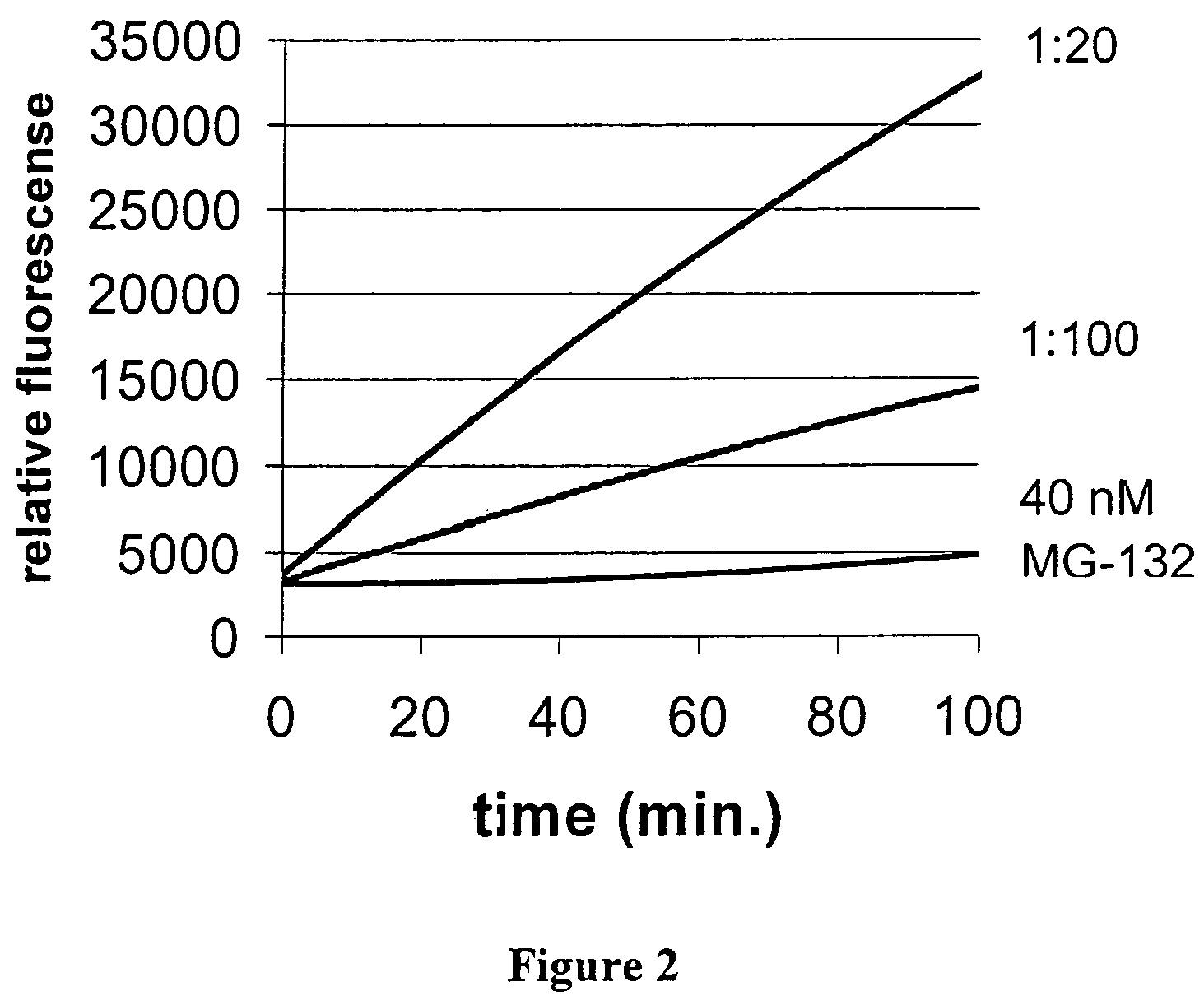Methods for identifying inhibitors of the 20S and 26S proteasome
a technology of proteasomes and inhibitors, applied in biocide, instruments, biochemistry apparatus and processes, etc., can solve the problems of limited number of known gene products, labour-intensive and expensive tests, and limited number of substances which can be tested in greenhouses
- Summary
- Abstract
- Description
- Claims
- Application Information
AI Technical Summary
Benefits of technology
Problems solved by technology
Method used
Image
Examples
example 1
Preparation of the Proteasome Extract from S. Cerevisiae Cells
[0106]150 ml of compact fermenter yeast were resuspended with 250 ml of buffer (50 mM Tris-HCl, pH 7.5; 10 mM EDTA) to give 400 ml of a yeast suspension. The cells were disrupted in three runs in a high-pressure homogenizer under a pressure of 1800 psi and at 27° C. After cell disruption, the pH was adjusted to 7.5 using 0.1 M NaOH. Immediately thereafter, the incubation was carried out at 60° C. for 60 minutes. The suspension was then centrifuged three times at 13 000 rpm in a JA20 rotor at 4° C. in order to remove the precipitated components. It was then possible to use a 1:100 dilution of the remaining supernatant which contains the proteasomes immediately in the assay for identifying inhibitors.
[0107]Since the activity can vary, depending on the state of fermentation of the cells, it is recommended to determine the activity of the proteasomes beforehand in order to be able to choose the appropriate dilution.
example 2
Preparation of the Proteasome Extract from U. Maydis Cells
[0108]Protoplasts were prepared from 50 ml of an U. maydis culture according to Schulz et al. (Schulz et al. (1990), The b alleles of Ustilago maydis, whose combinations program pathogenic development, code for polypeptides containing a homeodomain-related motif. Cell 60, 295-306). This was followed by pelleting the protoplasts at 2000 rpm for 5 min. Subsequently, the protoplasts were made to burst by adding 50 μl of buffer (50 mM Tris-HCl, pH 7.5; 10 mM EDTA), due to the altered osmotic conditions. Cell debris was pelleted by centrifugation at 13 000 rpm for 5 min. The supernatant was again incubated at 60° C. for 1 h followed by pelleting of the denatured proteins at 13 000 rpm for 5 min. The following activity test of the U. maydis proteasomes obtained determines the dilution to be used for the subsequent assay.
example 3
Assay System Check Using the Known Inhibitor MG-132 (Activity Assay)
[0109]The activity and inhibition assay which makes use of the known inhibitor MG-132 from Calbiochem and which is intended to check the usability of the method of the invention was carried out in 384-well MTPs (microtitre plates with 384 wells). A total volume of 50 μl per well contained 25 μl of enzyme buffer (10 mM Tris-HCl, 2 mM EDTA) containing the proteasomes (2.8 mg), 20 μl substrate solution (13 μM Suc-LLVY-AMC (SEQ. ID. NO. 1), 0.06% SDS, 10% DMSO, 10 mM Tris-HCl, pH 7.5; 2 mM EDTA) containing the substrate and 5 μl of the test substance (160 nN MG-132 in 5% DMSO). The preliminary measurement (fluorescence) was carried out at 360 / 465 nm (35 nm bandwidth). The incubation was carried out at 25° C. for 40 minutes. The fluorescence was measured again at 360 / 465 nm (35 nm bandwidth).
PUM
| Property | Measurement | Unit |
|---|---|---|
| Fraction | aaaaa | aaaaa |
| Electrical conductance | aaaaa | aaaaa |
| Electrical conductance | aaaaa | aaaaa |
Abstract
Description
Claims
Application Information
 Login to View More
Login to View More - R&D
- Intellectual Property
- Life Sciences
- Materials
- Tech Scout
- Unparalleled Data Quality
- Higher Quality Content
- 60% Fewer Hallucinations
Browse by: Latest US Patents, China's latest patents, Technical Efficacy Thesaurus, Application Domain, Technology Topic, Popular Technical Reports.
© 2025 PatSnap. All rights reserved.Legal|Privacy policy|Modern Slavery Act Transparency Statement|Sitemap|About US| Contact US: help@patsnap.com



